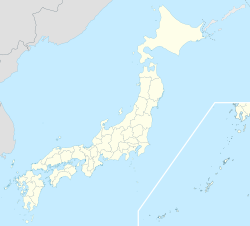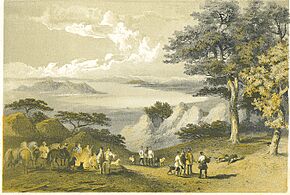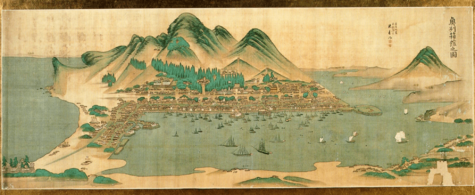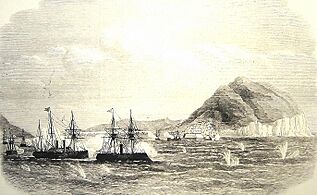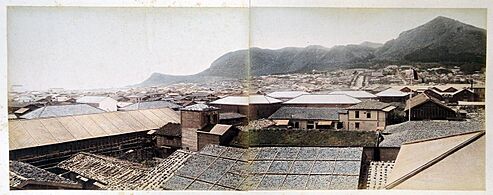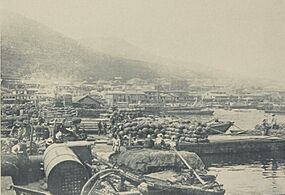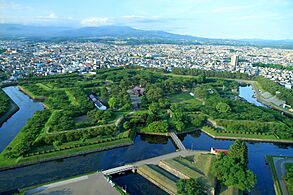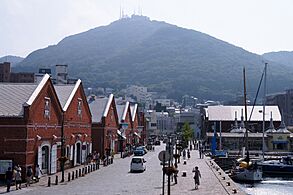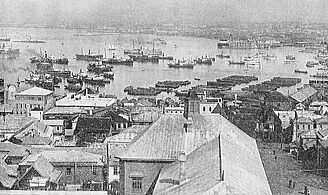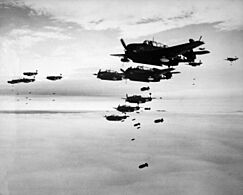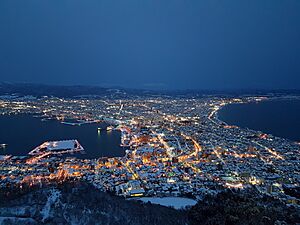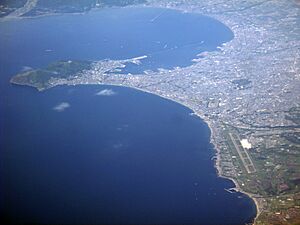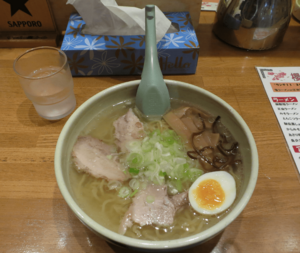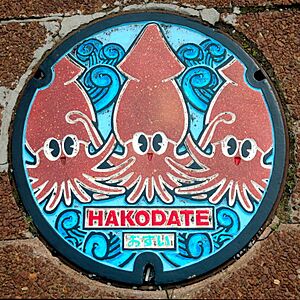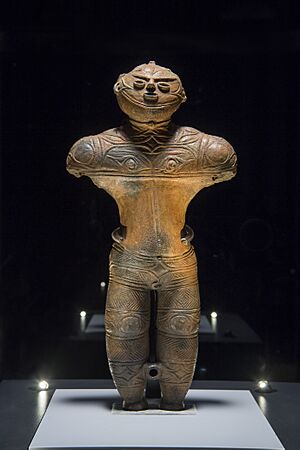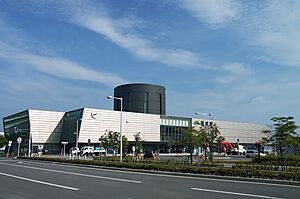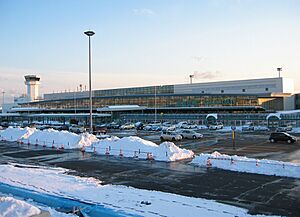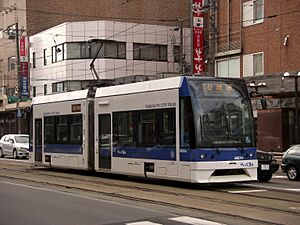Hakodate facts for kids
Quick facts for kids
Hakodate
函館市
|
|||||||||||||||
|---|---|---|---|---|---|---|---|---|---|---|---|---|---|---|---|
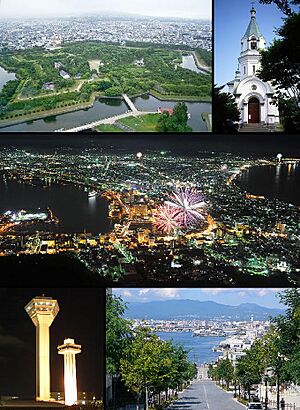
Clockwise from the top: Goryokaku, Hakodate Orthodox Church, Night View from Mount Hakodate, Goryokaku Tower, Hachiman-Zaka and Hakodate Port
|
|||||||||||||||
|
|||||||||||||||
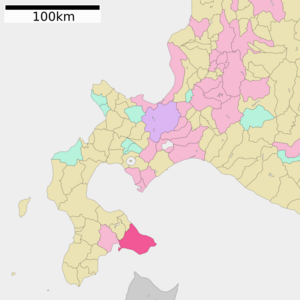 |
|||||||||||||||
| Country | Japan | ||||||||||||||
| Region | Hokkaido | ||||||||||||||
| Prefecture | Hokkaido (Oshima Subprefecture) | ||||||||||||||
| Area | |||||||||||||||
| • Total | 677.86 km2 (261.72 sq mi) | ||||||||||||||
| Elevation | 15 m (49 ft) | ||||||||||||||
| Population
(January 31, 2024)
|
|||||||||||||||
| • Total | 239,813 | ||||||||||||||
| • Density | 353.780/km2 (916.285/sq mi) | ||||||||||||||
| Time zone | UTC+9 (Japan Standard Time) | ||||||||||||||
| Phone number | 0138-21-3111 | ||||||||||||||
| Address | 4-13 Shinonome-chō, Hakodate-shi, Hokkaidō 040-8666 |
||||||||||||||
| Climate | Cfa | ||||||||||||||
|
|||||||||||||||
Hakodate (函館市, Hakodate-shi) is a city and port located in Oshima Subprefecture, Hokkaido, Japan. It is the main city of Oshima Subprefecture. As of January 31, 2024, about 239,813 people live there. The city covers an area of 677.86 square kilometres (261.72 sq mi). Hakodate is the third largest city in Hokkaido, after Sapporo and Asahikawa.
Contents
History of Hakodate
Hakodate was the first Japanese city to open its port to foreign trade in 1854. This happened because of the Convention of Kanagawa. It used to be the most important port in northern Japan. The city was also the biggest in Hokkaido before a big fire in 1934.
Early History
Hakodate, like many parts of Hokkaido, was first home to the Ainu. The name "Hakodate" might come from an Ainu word, "hak-casi," meaning "shallow fort." Another idea is that it means "box" or "building" in Japanese. This could refer to a castle built in the 1400s.
Hakodate was started in 1454. A person named Kono Kaganokami Masamichi built a large house in a fishing village called Usukeshi. Usukeshi was the Ainu word for "bay."
After Masamichi died, his family was forced out of Hakodate in 1512 during an Ainu rebellion. Not much history was written about the area for the next 100 years. There were often small fights with the Ainu in the Oshima area. This was because armed traders, like the Kono family, set up bases to control trade. A big uprising happened from 1669 to 1672, led by the Ainu warrior Shakushain. After this, the Ainu in the region were controlled.
Hakodate grew a lot during the Hoei period (1704–11). Many new temples were built. The city became even more important in 1741. This was when the Matsumae clan moved their government office to Hakodate.
In 1779, the Tokugawa shogunate (Japan's military government) took direct control of Hakodate. This led to fast growth in the area. A merchant named Takadaya Kahei helped make Hakodate a busy city. He is known as the founder of Hakodate port. He started trading operations, including a sea route to the Kuril island fisheries. A Hakodate government office was set up in 1802. By 1807, the Tokugawa government controlled the whole region. However, in 1821, the government gave control back to the Matsumae clan.
- Gallery
Meiji Restoration Era
In 1854, a group of five U.S. ships explored Hakodate port. This was part of the Convention of Kanagawa, agreed upon by Commodore Matthew Perry.
Hakodate port partly opened for foreign ships to get supplies the next year. Then, on June 2, 1859, it fully opened for foreign trade. It was one of five Japanese ports opened by the 1858 Treaty of Amity and Commerce with the U.S. The Hakodate foreign settlement shows the lasting influence of foreign visitors in Hakodate.
A sailor from Perry's fleet died during a visit. He was the first U.S. citizen buried in Japan, in Hakodate's foreigners' cemetery.
- Gallery
-
The Goryōkaku fortress in 1866.
A British merchant and naturalist, Thomas Blakiston, lived in Hakodate from 1861 to 1884. He studied the local nature and helped the weather station.
Hakodate was one of the few places in Japan that connected with the outside world. So, many countries opened consulates there. The Russian consulate had a chapel. From there, Nicholas of Japan helped bring Eastern Orthodox Christianity to Japan in 1861. Other historical churches, like Anglican and Catholic ones, are nearby.
Hakodate was also important in the Boshin War. This was a fight between the Tokugawa shogunate and the Meiji Emperor. A rebel leader, Enomoto Takeaki, came to Hakodate with his navy and French advisors in 1868. They started the Republic of Ezo. They tried to get other countries to recognize their republic, but they failed. The Naval Battle of Hakodate was fought from May 4 to 10, 1869. The Imperial Japanese Navy won this battle.
On June 14, 1868, Hakodate became an urban prefecture. It was one of the first two, with Kyoto being the other. Later, it became part of Hokkaido in 1886.
The rebels used Hakodate's famous European-style Goryōkaku fort as their main defense. Government forces defeated them in the Battle of Hakodate in 1869. The city and fort were given to the emperor. The military leader, Hijikata Toshizō, died in this fighting.
In 1878, a traveler named Isabella Bird wrote about the city. She said the streets were wide and clean, but the houses looked small and low. She noted that many roofs had stones on them to hold them down in the windy city.
20th Century to Today
Hakodate officially became a city on August 1, 1922. On March 21, 1934, a serious fire destroyed about two-thirds of all buildings. Many people left the city after this event. The city was mostly safe during World War II. Areas around Hakodate-yama were made stronger, and people could not go there. Many prisoners were held in 10 different camps in Hakodate. The city was bombed twice by Allied forces in July 1945. About 400 homes were destroyed, and a ferry was attacked, killing 400 passengers.
In 1976, a pilot from the Soviet Union named Viktor Belenko flew his plane into Hakodate's civilian airport.
Hakodate grew much larger on December 1, 2004. Several nearby towns and a village merged into it.
The Hokkaido Shinkansen (bullet train) line opened on March 26, 2016. This train line goes through the undersea Seikan Tunnel. It greatly reduced travel time from Honshu (Japan's main island) to Hakodate.
In April 2023, Jun Ōizumi became the mayor of Hakodate. He is the older brother of actor Yo Oizumi. He won against the previous mayor, getting more than 80% of the votes.
- Gallery
Geography of Hakodate
Mount Hakodate was once an island created by volcanoes millions of years ago. Over time, a sand bar formed between Mount Hakodate and the main land. This landform is called a tombolo. It finished forming around 1000 BCE. The tombolo connects the former island to the main island of Hokkaido. The central part of Hakodate city is built on this sandbar.
Hakodate is located in the middle of the Kameda Peninsula. Mount Hakodate overlooks the city. You can reach the top by hiking, cable car, or by car. Tour buses also go to the peak from JR Hakodate Station. People sometimes call the bumpy mountain Gagyūzan (Mount Cow's Back). This is because it looks like a resting cow.
The old Goryōkaku fort is now a public park. It is a popular place in Hokkaido for hanami (cherry blossom viewing). Since 2006, the park has a tall, white Goryōkaku Tower. It looks like an air traffic control tower. From the tower, you can see the whole park. On clear days, you can even see mainland Japan across the Tsugaru Strait.
Nearby Places
- Hokuto is to the west.
- Nanae is to the north.
- Shikabe is to the northeast.
Mountains in Hakodate
- Mount E (618 m (2,028 ft)): This is Hokkaido's southernmost volcano.
- Mount Hakodate (334 m (1,096 ft))
Rivers in Hakodate
- Kameda River (亀田川, Kameda-gawa)
- Matsukura River (松倉川, Matsukura-gawa)
- Shiodomari River (汐泊川, Shiodomari-gawa)
City View
Hakodate's city area covers the center of the Kameda peninsula. A narrow strip of land separates Hakodate Bay on the west from the Tsugaru Strait on the southeast. The best view of the city is from the top of Mount Hakodate.
Population Changes
The population of Hakodate grew a lot from 1873 to 1920. It went from 28,825 to 144,749 people. Hakodate's population was highest in 1980, with 320,154 people. But since then, the population has been slowly getting smaller because of aging.
| Census data | |||||||||||||||||||||||||||||||||||||||||||||||||||||||||||||||||||
|---|---|---|---|---|---|---|---|---|---|---|---|---|---|---|---|---|---|---|---|---|---|---|---|---|---|---|---|---|---|---|---|---|---|---|---|---|---|---|---|---|---|---|---|---|---|---|---|---|---|---|---|---|---|---|---|---|---|---|---|---|---|---|---|---|---|---|---|
|
|
||||||||||||||||||||||||||||||||||||||||||||||||||||||||||||||||||
| Source: Statistics Bureau [1], Japanese Imperial Commission [2] (1873) | |||||||||||||||||||||||||||||||||||||||||||||||||||||||||||||||||||
Climate and Weather
Hakodate has a climate with hot summers and snowy winters. It gets a lot of snow each year, about 380 cm (150 in) on average. Spring starts with some snow but gets warmer. Summers are usually warm but not too hot. The warmest month, August, has average high temperatures around 26 °C (79 °F). Fall starts warm but gets colder. It's not unusual to see snow late in the fall.
| Climate data for Hakodate (1991−2020 normals, extremes 1872−present) | |||||||||||||
|---|---|---|---|---|---|---|---|---|---|---|---|---|---|
| Month | Jan | Feb | Mar | Apr | May | Jun | Jul | Aug | Sep | Oct | Nov | Dec | Year |
| Record high °C (°F) | 12.5 (54.5) |
13.6 (56.5) |
16.9 (62.4) |
23.0 (73.4) |
28.0 (82.4) |
29.1 (84.4) |
33.6 (92.5) |
35.4 (95.7) |
32.6 (90.7) |
27.8 (82.0) |
21.5 (70.7) |
16.3 (61.3) |
35.4 (95.7) |
| Mean daily maximum °C (°F) | 0.9 (33.6) |
1.8 (35.2) |
5.8 (42.4) |
12.0 (53.6) |
17.0 (62.6) |
20.4 (68.7) |
24.1 (75.4) |
25.9 (78.6) |
23.2 (73.8) |
17.1 (62.8) |
10.0 (50.0) |
3.2 (37.8) |
13.5 (56.3) |
| Daily mean °C (°F) | −2.4 (27.7) |
−1.8 (28.8) |
1.9 (35.4) |
7.3 (45.1) |
12.3 (54.1) |
16.2 (61.2) |
20.3 (68.5) |
22.1 (71.8) |
18.8 (65.8) |
12.5 (54.5) |
6.0 (42.8) |
−0.1 (31.8) |
9.4 (48.9) |
| Mean daily minimum °C (°F) | −6.0 (21.2) |
−5.7 (21.7) |
−2.2 (28.0) |
2.8 (37.0) |
8.0 (46.4) |
12.6 (54.7) |
17.3 (63.1) |
18.9 (66.0) |
14.6 (58.3) |
7.8 (46.0) |
1.8 (35.2) |
−3.6 (25.5) |
5.5 (41.9) |
| Record low °C (°F) | −21.7 (−7.1) |
−20.4 (−4.7) |
−18.9 (−2.0) |
−8.6 (16.5) |
−5.0 (23.0) |
2.0 (35.6) |
6.3 (43.3) |
9.0 (48.2) |
1.7 (35.1) |
−4.0 (24.8) |
−12.1 (10.2) |
−19.4 (−2.9) |
−21.7 (−7.1) |
| Average precipitation mm (inches) | 77.4 (3.05) |
64.5 (2.54) |
64.1 (2.52) |
71.9 (2.83) |
88.9 (3.50) |
79.8 (3.14) |
123.6 (4.87) |
156.5 (6.16) |
150.5 (5.93) |
105.6 (4.16) |
110.8 (4.36) |
94.6 (3.72) |
1,188 (46.77) |
| Average snowfall cm (inches) | 91 (36) |
74 (29) |
41 (16) |
2 (0.8) |
0 (0) |
0 (0) |
0 (0) |
0 (0) |
0 (0) |
0 (0) |
18 (7.1) |
79 (31) |
306 (120) |
| Average precipitation days (≥ 0.5 mm) | 19.9 | 17.5 | 16.8 | 12.2 | 11.1 | 8.9 | 10.2 | 10.4 | 11.9 | 12.9 | 16.7 | 19.2 | 167.7 |
| Average relative humidity (%) | 73 | 71 | 68 | 67 | 73 | 79 | 82 | 81 | 76 | 73 | 71 | 74 | 74 |
| Mean monthly sunshine hours | 103.1 | 117.9 | 158.7 | 186.1 | 198.5 | 172.6 | 134.4 | 148.0 | 160.8 | 163.9 | 109.4 | 91.5 | 1,744.9 |
| Average ultraviolet index | 1 | 2 | 4 | 6 | 8 | 9 | 9 | 8 | 6 | 4 | 2 | 1 | 5 |
| Source 1: Japan Meteorological Agency | |||||||||||||
| Source 2: Weather Atlas (UV) | |||||||||||||
Economy
Before it closed, Air Hokkaido had its main office in Hakodate. In 2006, the airline Airtransse also had its main office there.
Culture and Landmarks
In Funami-cho, you can find the Koryu-ji temple. It is the oldest Buddhist temple in the area, built in 1633. It was badly damaged during the Boshin War. It moved to its current spot in 1879. The main building you see today was built in 1900.
The city is famous for its seafood and sushi. Hakodate shio (salt) ramen is also a well-known dish. Shio ramen has a light, clear soup made with salt and different meats, vegetables, or seaweed. Also, the city's official fish is the squid. Hakodate is known for a restaurant called Ikkatei Tabiji. They serve a dish called "dancing squid." This is a recently deceased squid that moves when soy sauce is poured on it.
Every August, the city holds the Hakodate Port Festival. Many people gather to do the Ika-odori (Squid Dance). The name perfectly describes the dance. At night, you can see the bright lights of squid-fishing boats on the water around the city. The bell of Haristos Orthodox Church is one of the 100 Soundscapes of Japan.
The Hakodate Fish Market, also called Asaichi or the Morning Market, is a short walk from JR Hakodate Station. It is open every day. It has hundreds of stands selling fish and seafood. There are also many restaurants. Popular foods include sea urchin and snow crab from Hokkaido's waters.
- Hakodate City Museum
- Hakodate City Museum of Literature
- Hakodate City Museum of Northern Peoples
- Hakodate Hachiman Shrine
- Hakodate Museum of Art, Hokkaido
- Hakodate Jōmon Culture Center
- Hakodate Park
- Mount Hakodate Ropeway
- Our Lady of the Angels Trappistine Abbey
- Shinori-date
- Shiryōkaku
Transportation
The Hakodate Transportation Bureau runs tram (light rail) lines.
The Hokkaido Shinkansen (bullet train) opened in March 2016. It currently goes to Shin-Hakodate-Hokuto Station. It travels through the Seikan Tunnel from Shin-Aomori Station. The new train station is 17 km (11 mi) away from Hakodate Station. There are plans to extend the Shinkansen line north to Sapporo Station by 2030.
- JR Hokkaido station
- Hakodate Main Line: Hakodate Station - Goryōkaku Station - Kikyō Station
- South Hokkaido Railway Company: Goryōkaku Station
- Hakodate Airport
- Port of Hakodate
- Hokkaido Expressway
Media
In Hakodate, there are many ways to get news and information. These include newspaper companies, TV stations, and radio stations.
Newspapers
- Hakodate Newspaper
Television
- HBC Hakodate Broadcasting Station
- NHK Hakodate Broadcasting Station
- STV Hakodate Broadcasting Station
Radio
- FM Iruka
Cable TV
- NCV Hakodate Center
Education
Universities
National Universities
- Hokkaido University, Hakodate Campus
- Hokkaido University of Education, Hakodate Campus
Public Universities
- Future University Hakodate
Private Universities
- Hakodate University
- Hakodate Junior College
- Hakodate Otani College
- Russia Kyokutou University Hakodate school
Colleges
National Colleges
- Hakodate National College of Technology
High Schools
Public High Schools
- Hakodate City High School
- Hokkaido Hakodate Chubu High School
- Hokkaido Hakodate Commercial High School
- Hokkaido Hakodate Nishi High School
- Hokkaido Hakodate Ryohoku High School
- Hokkaido Hakodate Technical High School
- Hokkaido Minamikayabe High School
- Hokkaido Toi High School
Private High Schools
- Hakodate La Salle Junior High School & Senior High School
- Hakodate Shirayuri Gakuen Junior High School & Senior High School
- Hakodate Otani High School
- Hakuryo High School affiliated with Hakodate University
- Iai Joshi Women's Academy
- Otsuma High School
- Seisho Gakuin High School
- Yuto High School affiliated with Hakodate University
Sister Cities
Hakodate has special connections with several cities around the world. These are called "sister cities."
 Halifax, Nova Scotia, Canada (since 1982)
Halifax, Nova Scotia, Canada (since 1982) Vladivostok, Primorsky Krai, Russia (since 1992)
Vladivostok, Primorsky Krai, Russia (since 1992) City of Lake Macquarie, New South Wales, Australia (since 1992)
City of Lake Macquarie, New South Wales, Australia (since 1992) Yuzhno-Sakhalinsk, Sakhalin Oblast, Russia (since 1997)
Yuzhno-Sakhalinsk, Sakhalin Oblast, Russia (since 1997) Singapore, since 1992 (Treaty of Friendship)
Singapore, since 1992 (Treaty of Friendship) Tianjin, China (since 2001)
Tianjin, China (since 2001) Goyang, Gyeonggi-do, South Korea (since 2011)
Goyang, Gyeonggi-do, South Korea (since 2011)
Notable People
These are some famous people who are from Hakodate:
- Glay, a rock/pop band
- Great Kojika, a Japanese professional wrestler
- Juran Hisao, a mystery writer
- Kōhan Kawauchi, a screenwriter
- Saburō Kitajima, a singer
- Hidemi Kon, a literary critic
- Naoko Matsui, a voice actress
- Gorô Naya, a voice actor
- Kogo Noda, a screenwriter
- Kazuo Ohno, a Butoh dancer
- Menso-re Oyaji, a Japanese professional wrestler
- Hideko Takamine, an actress
- Yuki, a musician
See also
 In Spanish: Hakodate para niños
In Spanish: Hakodate para niños




